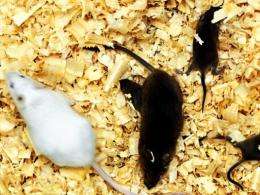Reproductive scientists create mice from 2 fathers

Using stem cell technology, reproductive scientists in Texas, led by Dr. Richard R. Berhringer at the M.D. Anderson Cancer Center, have produced male and female mice from two fathers.
The study was posted today (Wednesday, December 8) at the online site of the journal Biology of Reproduction.
The achievement of two-father offspring in a species of mammal could be a step toward preserving endangered species, improving livestock breeds, and advancing human assisted reproductive technology (ART). It also opens the provocative possibility of same-sex couples having their own genetic children, the researchers note.
In the work reported today, the Behringer team manipulated fibroblasts from a male (XY) mouse fetus to produce an induced pluripotent stem (iPS) cell line. About one percent of iPS cell colonies grown from this XY cell line spontaneously lost the Y chromosome, resulting in XO cells. The XO iPS cells were injected into blastocysts from donor female mice. The treated blastocysts were transplanted into surrogate mothers, which gave birth to female XO/XX chimeras having one X chromosome from the original male mouse fibroblast.
The female chimeras, carrying oocytes derived from the XO cells, were mated with normal male mice. Some of the offspring were male and female mice that had genetic contributions from two fathers.
According to the authors, "Our study exploits iPS cell technologies to combine the alleles from two males to generate male and female progeny, i.e. a new form of mammalian reproduction."
The technique described in this study could be applied to agriculturally important animal species to combine desirable genetic traits from two males without having to outcross to females with diverse traits.
"It is also possible that one male could produce both oocytes and sperm for self-fertilization to generate male and female progeny," the scientists point out. Such a technique could be valuable for preserving species when no females remain.
In the future, it may also be possible to generate human oocytes from male iPS cells in vitro. Used in conjunction with in vitro fertilization, this would eliminate the need for female XO/XX chimeras, although a surrogate mother would still be needed to carry the two-father pregnancy to term.
Using a variation of the iPS technique, the researchers say "it may also be possible to generate sperm from a female donor and produce viable male and female progeny with two mothers."
The authors also caution that the "generation of human iPS cells still requires significant refinements prior to their use for therapeutic purposes."
Provided by Society for the Study of Reproduction
















